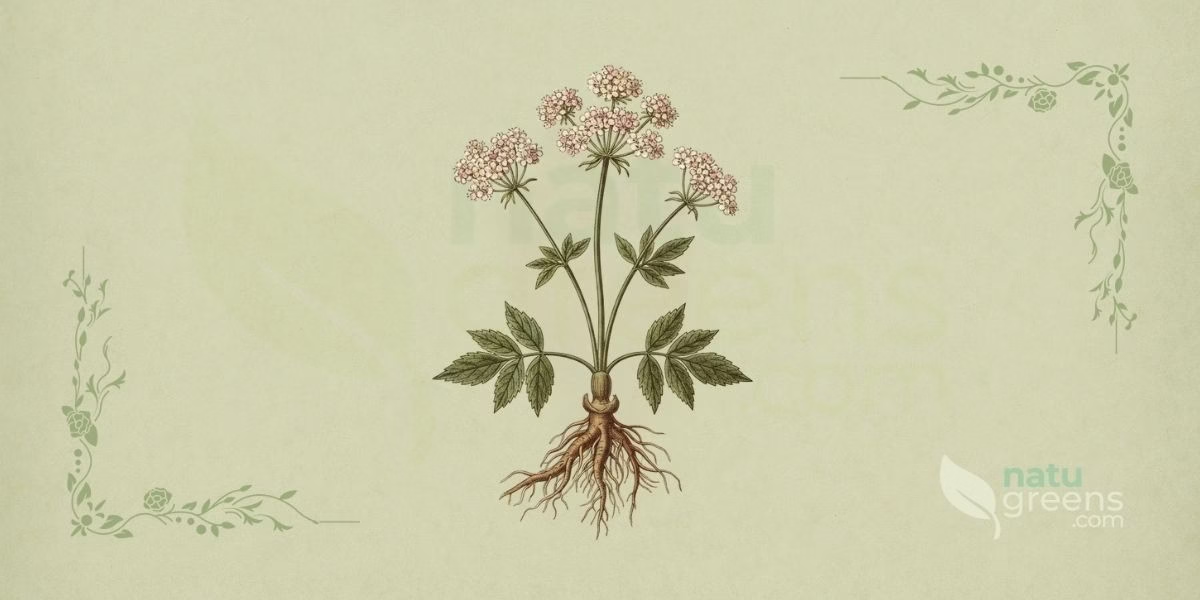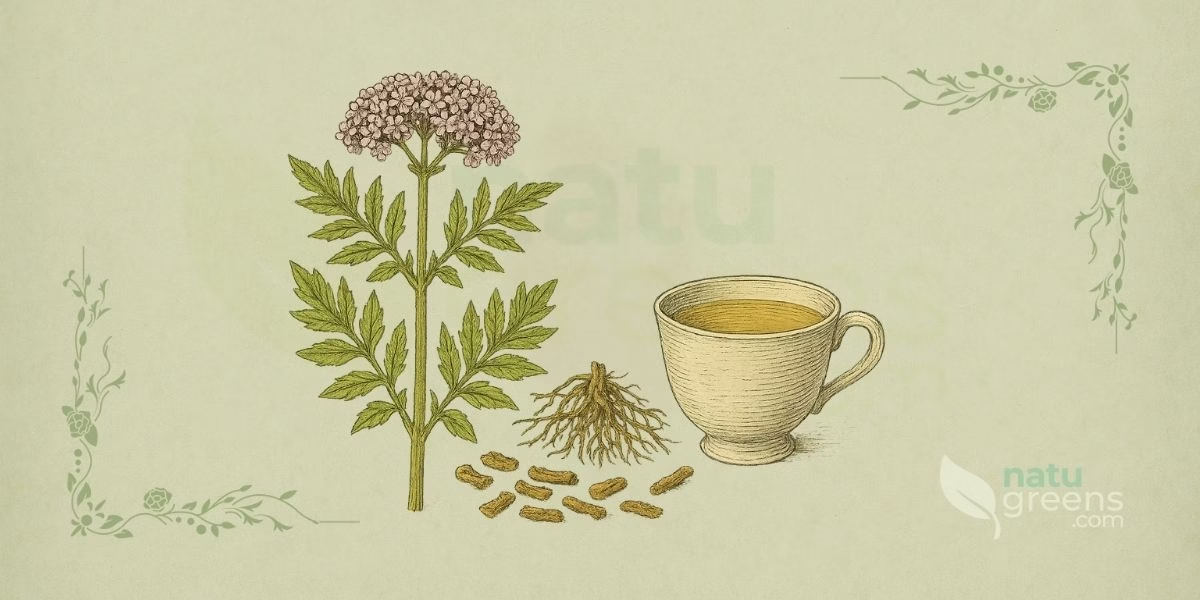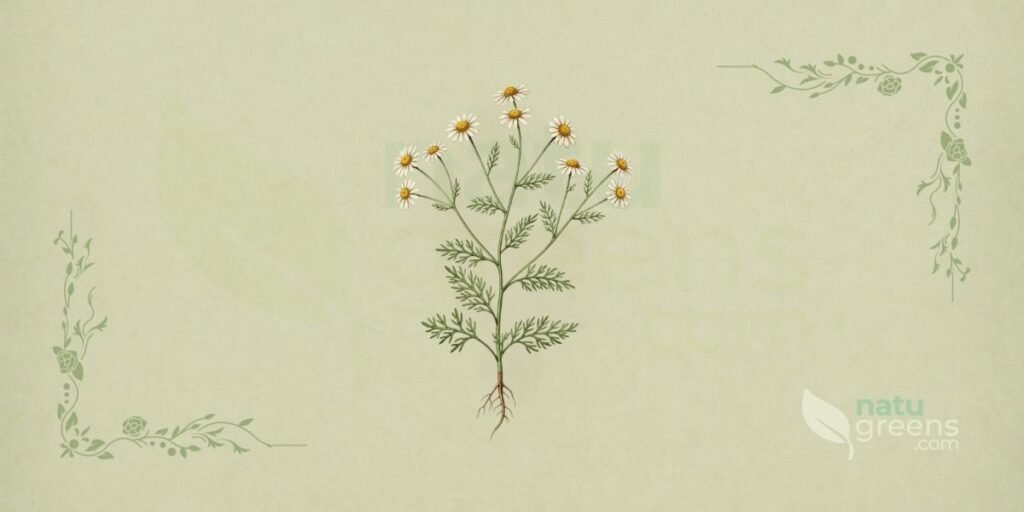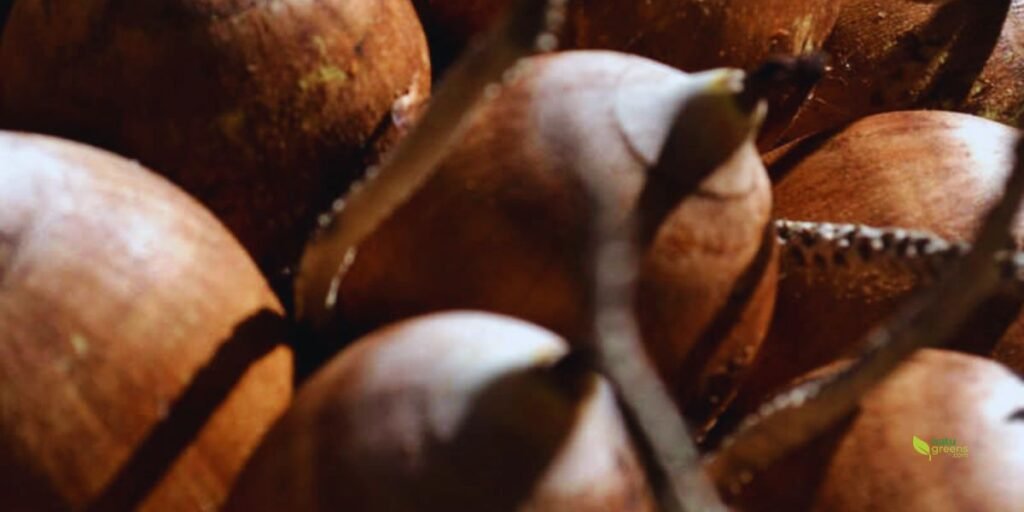Valeriana officinalis L. / Valerian, commonly known as valerian, catnip, and garden heliotrope, is a perennial herbaceous plant belonging to the family Caprifoliaceae, formerly classified as Valerianaceae. Described by Carl Linnaeus in 1753, this species is native to Europe and some regions of Asia, having naturalized in various parts of the world due to its extensive medicinal use. Valerian is primarily recognized for its sedative and anxiolytic properties, with the root and rhizome being the most utilized parts in herbal medicine. Its use dates back to Ancient Greece, where it was employed to treat insomnia and nervousness, and its name derives from the Latin valere, meaning “to be healthy” or “to be strong.”
The valerian root has a characteristic strong odor attributed to the presence of isovaleric acids and other volatile compounds. Although unpleasant to humans, this scent is notably attractive to cats, which gives it the popular name catnip. The efficacy of valerian in treating sleep disorders and anxiety has been the subject of intense scientific research, identifying active compounds such as valerenic acids and valepotriates.
These compounds interact with the central nervous system, promoting relaxation and improving sleep quality without the common side effects of many synthetic sedatives. The European Medicines Agency (EMA) monograph recognizes its use for relieving mild symptoms of nervous tension and sleep disturbances, consolidating its importance in modern herbal medicine.
Popular and International Names of Valeriana officinalis
- English: all-heal, common valerian, garden heliotrope, valerian.
- French: herbe aux chats, valériane, valériane officinale.
- German: Baldrian, Echter Baldrian, Katzenkraut.
- Italian: erba gatta, valeriana, valeriana comune.
- Portuguese: erva-dos-gatos, valeriana, valeriana-comum, valeriana-das-boticas, valeriana-oficial.
- Spanish: hierba de los gatos, valeriana, valeriana oficinal.
Botanical Synonyms of Valeriana officinalis
The accepted name for the species is Valeriana officinalis L., but the plant presents a complex taxonomy due to its wide distribution and morphological variation, leading to the description of several subspecies and varieties. The term Valeriana is sometimes used to designate a complex of morphologically similar species. In scientific literature and pharmacopoeias, some botanical synonyms can be found, although Valeriana officinalis L. remains the preferentially used name. Taxonomic confusion partly arises from the existence of other species within the genus with similar medicinal properties, such as Valeriana edulis and Valeriana wallichii, which are sometimes used as substitutes or adulterants.
Despite this complexity, most herbal products marketed in Europe and North America use the root of Valeriana officinalis L. or standardized extracts derived from this species. Correct species identification is crucial to ensure product safety and efficacy, as phytochemical composition can vary significantly between species. The European Pharmacopoeia establishes strict criteria for identification and active constituent content in the herbal drug, focusing mainly on valerenic acid content. Standardization is essential for conducting consistent clinical studies and guaranteeing herbal medicine quality.
- Valeriana baltica Pleijel,
- Valeriana capitata Pall. ex Link
- Valeriana collina Wallr
- Valeriana exaltata Mikan
- Valeriana luchenensis S.L.Liou & A.E.Boriss
- Valeriana nitida Kreyer
- Valeriana palustris Kreyer
- Valeriana procurrens Wallr
- Valeriana sambucifolia Mikan
- Valeriana spryginii P.A.Smirn
- Valeriana tenuifolia Vahl
- Valeriana turuchanica P.A.Smirn
Botanical Family: Caprifoliaceae

Botanical illustration of Valeriana officinalis L. (valerian, common valerian, garden heliotrope), a perennial herb from the Caprifoliaceae family, native to Europe and Southwest Asia, described by Carl Linnaeus in 1753, detailing the rhizome and fibrous roots, which are the most important parts of the plant due to the concentration of bioactive compounds such as valerenic acids and valepotriates, in a 19th-century botanical encyclopedia style on a herbarium paper background.
Valeriana officinalis belongs to the family Caprifoliaceae, formerly known as Valerianaceae. This family comprises about 860 species distributed across 42 genera, including shrubs, trees, and herbs. Plants in this family are known for their tubular flowers and fruit in the form of berries or capsules. The taxonomic reclassification of valerian into Caprifoliaceae was based on molecular phylogenetic studies demonstrating a closer relationship with genera such as Lonicera (honeysuckle) and Sambucus (elderberry). Many species in the Caprifoliaceae family have ornamental and medicinal importance, with valerian being one of the most prominent examples due to its therapeutic properties.
Family Characteristics
The family is characterized by generally showy flowers and varied fruits, including berries and capsules. It consists of shrubs, trees, and more frequently herbaceous plants, mainly distributed in temperate regions of the Northern Hemisphere. Caprifoliaceae is known for including plants with ornamental flowers and some species with medicinal importance. The reclassification was based on genetic analyses that demonstrated a close evolutionary relationship between members of the former Valerianaceae and Caprifoliaceae, resulting in their merger.
Valeriana, as a member of this family, shares botanical features such as pinnate leaves and small flowers grouped in terminal inflorescences. Its inclusion in Caprifoliaceae reflects a more accurate understanding of evolutionary relationships within the plant kingdom. Other notable family members include elderberry (Sambucus) and honeysuckle (Lonicera). The Caprifoliaceae family is chemically diverse, producing iridoid glycosides, saponins, and essential oils, contributing to the medicinal properties of many of its species. Valerian root, in particular, is rich in valepotriate-type iridoids, which are unstable and thermolabile compounds whose degradation generates the characteristic odor of the plant.
Parts Used of Valeriana officinalis
Herbal medicine primarily uses the underground parts of Valeriana officinalis, which are the main source of its bioactive compounds. Harvesting is generally performed in autumn when the concentration of active constituents, such as valerenic acids, reaches its peak. The root and rhizome undergo drying processes and sometimes fermentation, influencing the final chemical composition of the plant material. The preparation method and extraction solvent determine the concentration and stability of the compounds, with hydroalcoholic extracts being the most common in standardized products.
- Dry and fluid extracts (standardized in valerenic acids)
- Essential oil (obtained by steam distillation of root and rhizome)
- Rhizome
- Root (Radix)
- Tinctures
Ethnobotanical and Traditional Uses of Valeriana officinalis
Valerian’s use as a medicinal plant has a long history dating back centuries. In Ancient Greece, Hippocrates and Galen prescribed it for treating insomnia. During the Middle Ages, it was considered an “all-heal,” used for a wide range of ailments from epilepsy to headaches. Its use as a sedative and anxiolytic became established in Europe, widely used to calm nerves and promote sleep. Folk tradition also employed it to relieve menstrual cramps and muscle pain. Its traditional use is recognized by the EMA for alleviating mild symptoms of mental stress and aiding sleep.
- Anxiety and nervousness
- Headaches and migraines
- Gastrointestinal spasms
- Insomnia and sleep disorders
- Irritability and agitation
- Light mental stress and nervous tension
- Palpitations of nervous origin
- Restless legs syndrome
- Stress
- Hysteria and panic attacks
Medicinal Properties of Valeriana officinalis
The therapeutic properties of valerian are predominantly attributed to its ability to modulate the central nervous system, mainly through interaction with the GABA-A receptor. Valerenic acid, one of its main constituents, has been shown to inhibit the degradation of GABA (gamma-aminobutyric acid), the brain’s primary inhibitory neurotransmitter, resulting in a calming effect. Additionally, valerian exhibits other pharmacological activities contributing to its therapeutic profile. Its action is gradual rather than immediate, which justifies the recommendation of continuous use for several weeks to achieve the full therapeutic effect, especially in chronic insomnia treatment.
- Anxiolytic (reduces anxiety and nervous tension)
- Anticonvulsant (may help prevent seizures)
- Antispasmodic (relieves muscle spasms and cramps)
- Hypnotic (induces sleep)
- Muscle relaxant (promotes muscle relaxation)
- Neuroprotective (protects nerve cells)
- Sedative (calms the nervous system)
- Tranquilizer (reduces tension and agitation)
Detailed Phytochemical Profile of Valeriana officinalis
The complexity of the phytochemical profile of Valeriana officinalis explains why its mechanism of action cannot be attributed to a single compound but rather to a synergy of several classes of substances. More than 150 chemical constituents have been identified in valerian root. The main groups of compounds include sesquiterpenes, iridoids, and flavonoids.
The concentration of these compounds varies depending on geographic origin, cultivation method, harvest time, and drying and extraction processes. Extract standardization is generally based on valerenic acid content, considered markers of quality and efficacy.
- Gamma-aminobutyric acid (GABA)
- Isovaleric acid
- Other amino acids (arginine, glutamine)
- Phenolic acids
- Sesquiterpenes (valerenic acid, hydroxyvalerenic acid, acetoxyvalerenic acid)
- Essential oils (0.5–2.0%)
- Flavonoids (apigenin, hesperidin, linarin)
- Iridoids (valepotriates, valtrate, didrovaltrate)
- Lignans (hydroxy-pinoresinol, pinoresinol)
- Monoterpenes (borneol, bornyl acetate)
- Alkaloids (actinidine, chatinine, valerianine, valerine)
- Triterpenes (ursolic acid)
Preparation and Administration Forms of Valeriana officinalis
Valerian can be administered in various forms, with the choice depending on the therapeutic purpose and patient preference. Infusion and decoction are traditional usage methods, but standardized extracts in capsules or tablets are preferred in clinical herbal medicine due to precise dosing of active constituents. Valerian root should be handled carefully due to its strong odor. Essential oil, although less common, is sometimes used in aromatherapy or as an additive in relaxing baths. The EMA recognizes the use of comminuted herbal substance (herbal tea) and various extracts (dry, liquid, tinctures) for oral use.
- Capsules and tablets (with standardized dry extract)
- Decoction (for the root)
- Dry extract
- Fluid extract
- Infusion (with comminuted root)
- Tincture (hydroalcoholic extract)
Synergy with Other Medicinal Plants
Valerian is often combined with other plants possessing sedative and anxiolytic properties to enhance its effects and broaden the spectrum of action. This synergy allows the use of lower doses of each plant, minimizing the risk of side effects. Combining valerian with plants acting through different mechanisms, such as GABA modulation and serotonin receptor activity, may result in a more complete and effective therapeutic effect in treating sleep and anxiety disorders. Modern herbal medicine values these combinations to optimize clinical outcomes.
Anxiety and Insomnia
Valerian (Valeriana officinalis) is frequently combined with other sedative and anxiolytic plants to potentiate its effects. The synergy with passionflower (Passiflora incarnata) and chamomile (Matricaria chamomilla) is particularly effective in treating sleep disorders and nervous states. Valerian acts on GABA receptors, while passionflower contributes harmala alkaloids and chamomile provides apigenin, creating a synergistic calming effect that can be an alternative to synthetic sedatives.
Stress and Nervous Tension
For relieving stress and nervous tension, valerian can be combined with lemon balm (Melissa officinalis) and hops (Humulus lupulus). Lemon balm has relaxing properties, and hops contain compounds with sedative action, complementing valerian’s effects. This combination is useful for promoting relaxation without causing excessive daytime drowsiness.
Valerian and Lemon Balm (Melissa officinalis)
Lemon balm is valued for its anxiolytic and carminative properties. Its combination with valerian is ideal for patients experiencing anxiety associated with gastrointestinal disorders such as spasms and flatulence. Lemon balm’s essential oils, rich in citral and citronellal, provide an additional calming effect and a more pleasant flavor to the infusion, masking valerian’s strong odor. This synergy benefits the relief of stress and nervous tension manifesting physically in the digestive system.
Valerian and Hops (Humulus lupulus)
Hops, known for their cones used in beer production, possess sedative properties that complement valerian’s. The bitter acids in hops, such as lupulin, have a calming effect which, synergized with valerenic acids, is particularly effective in inducing sleep. This combination is frequently used in commercial sleep products, making hops an excellent adjuvant to valerian, especially in cases of agitation and difficulty falling asleep.
Valerian and Passionflower (Passiflora incarnata)
The combination of valerian and passionflower is one of the most common protocols for treating insomnia and anxiety. While valerian primarily acts through the GABAergic system, passionflower contains flavonoids such as chrysin that also show affinity for GABA-A receptors. This dual sedative and anxiolytic action provides deeper relaxation and significant improvement in sleep latency and quality. Passionflower also contributes an antispasmodic effect useful for muscle tension associated with stress.
Valeriana officinalis Recipes and Usage Protocols

19th-century encyclopedia-style botanical illustration depicting a scene of Valeriana officinalis (valerian) herbal tea preparation, with a porcelain cup containing golden tea, dried valerian roots, honey in a small container, and a lemon slice, harmoniously arranged on an aged sage-green herbarium paper background.
Valerian use should be consistent and prolonged to obtain maximum benefit, especially for chronic sleep disorders. Preparations should preferably be consumed at night, about 30 minutes to one hour before bedtime. Dosage must be individually adjusted, starting with the minimum effective dose and gradually increasing if necessary under healthcare professional guidance. It is important to note that valerian should not be used for acute insomnia treatment but rather as a long-term supportive therapy.
Relaxing Bath with Valerian Root
Ingredients: 100 grams of comminuted valerian root, hot water.
Preparation: Place the root in a cloth bag and suspend it in the bathtub water. Fill the tub with water at a temperature between 34-37°C. Remain in the bath for 10 to 20 minutes. This traditional use is recognized by the EMA as a bath additive for relieving mild mental stress symptoms. It is important that the water is not too hot to avoid degradation of volatile compounds. This method is contraindicated in cases of open wounds or acute skin diseases.
Dry Extract Capsules for Sleep Disorders
Ingredients: Dry valerian root extract (400-600 mg), standardized in valerenic acids.
Protocol: Take one capsule (400-600 mg) half an hour to one hour before bedtime. The EMA’s maximum recommended daily dose for well-established use is four single doses. Treatment should continue for 2 to 4 weeks to achieve the full therapeutic effect. This form is the most used in clinical trials and is ideal for those who do not tolerate the infusion’s taste.
Infusion for Chronic Insomnia
Ingredients: 1 to 3 grams of comminuted valerian root, 150 ml boiling water.
Preparation: Place the valerian root in a cup and add boiling water. Cover and let infuse for 10 to 15 minutes. Strain and drink. Boiling the root is not recommended as excessive heat can degrade valepotriates. Consume one cup 30 minutes to one hour before bedtime. For mild mental stress, it can be consumed up to three times a day. The flavor can be improved by adding honey or lemon balm.
Standardized Tincture for Anxiety
Ingredients: Valeriana officinalis tincture (drug-extract ratio 1:5, ethanol 60-80% v/v solvent).
Protocol: Take 1 to 3 ml of tincture diluted in a little water, up to three times a day, for relieving mild nervous tension symptoms. To aid sleep, take an additional dose 30 minutes to one hour before bedtime. The tincture is an administration form that ensures more consistent dosing of active compounds, preferred by many herbalists. Dosage should follow manufacturer or healthcare professional recommendations.
Associated Therapies with Valeriana officinalis
Valerian can be integrated into various complementary therapeutic approaches, enhancing its effects and addressing underlying causes of sleep and anxiety disorders. Its action on the central nervous system makes it an excellent adjuvant in therapies aiming at emotional rebalancing and stress reduction. Combining herbal medicine with other therapeutic modalities is a holistic approach targeting the patient’s overall well-being.
Aromatherapy
Valerian essential oil, despite its intense and earthy odor, is used in aromatherapy for its sedative properties. Inhalation of the oil, diluted in diffusers or massage oils, can promote deep relaxation and aid sleep induction. It is often combined with more pleasant essential oils such as lavender or chamomile to improve acceptance. Aromatherapy with valerian is particularly useful for reducing anxiety and nervous tension before bedtime.
Clinical Herbal Medicine
In clinical herbal medicine, valerian is a cornerstone in treating sleep and anxiety disorders. It is prescribed as standardized extracts, ensuring valerenic acid concentration. Treatment is individualized, considering symptom severity, presence of other medical conditions, and concurrent medication use. Clinical herbal medicine uses valerian as an alternative or complement to synthetic anxiolytics and hypnotics, with a more favorable safety profile for long-term use.
Homeopathy
In homeopathy, valerian is used to treat states of nervousness, hypersensitivity, and insomnia, especially when associated with agitation and muscle spasms. The homeopathic remedy is prepared from the mother tincture of fresh root, following dilution and potentization processes. It is often indicated for patients with sensory and emotional hypersensitivity, mood fluctuations, and difficulty relaxing. Homeopathy uses valerian in various potencies depending on symptom chronicity and nature.
Valerian essential oil, extracted from the roots, is used in aromatherapy for its relaxing and sedative properties. Inhaling the aroma through diffusers or diluted in vegetable oil for massages can help reduce stress and anxiety and promote restful sleep. It is often combined with lavender or bergamot essential oils to create synergies that enhance calming effects.
Contraindications and Side Effects of Valeriana officinalis
Valerian is generally considered safe when used at recommended therapeutic doses. However, like any herbal medicine, it has contraindications and may cause side effects in some individuals. Valerian’s safety has been extensively studied, and the EMA provides clear guidelines on its safe use. It is essential that patients inform their doctor or pharmacist about valerian use, especially if taking other medications or having preexisting medical conditions.
Contraindications
The primary contraindication is known hypersensitivity to the active substance or any excipients. Use in children under 12 years is not recommended for well-established use due to lack of safety and efficacy data in this age group. Bath additive use is contraindicated in cases of open wounds, large skin lesions, acute skin diseases, high fever, severe infections, severe circulatory disorders, and heart failure.
- Children: Should not be administered to children under three years old, and in older children only under medical supervision.
- Hepatic Disease: Individuals with liver disease should use valerian cautiously and under medical supervision due to rare potential hepatotoxicity.
- Interactions with CNS Depressants: Avoid concomitant use with alcohol, benzodiazepines, barbiturates, opioids, kava, or antihistamines, as it may potentiate sedative effects and cause excessive central nervous system depression.
- Pregnancy and Lactation: Use during pregnancy and breastfeeding is not recommended due to lack of conclusive safety studies.
- Surgery: It is recommended to discontinue valerian at least two weeks before any surgery due to its sedative potential and interactions with anesthetics.
Common Side Effects
Valerian’s side effects are generally mild and transient. The most common include gastrointestinal symptoms such as nausea, abdominal cramps, and diarrhea. In some cases, daytime drowsiness, dizziness, or headache may occur, especially if the dose is too high or combined with other sedatives. Hypersensitivity reactions, such as skin rashes, are rare but possible. Occurrence of side effects should lead to dose reduction or treatment discontinuation.
Drug Interactions
Valerian may potentiate the effect of other central nervous system depressants, including alcohol, barbiturates, benzodiazepines, and antidepressants. This interaction can increase sedation and drowsiness, which may be dangerous, especially when driving or operating machinery. It is crucial that patients avoid alcohol consumption during valerian treatment and consult a healthcare professional before combining it with any other CNS-acting medication. Valerian may also interact with drugs metabolized by cytochrome P450 enzymes, although the clinical relevance of this interaction remains controversial.
- Allergic Reactions: In very rare cases, allergic reactions such as skin eruptions or itching may occur.
- Daytime Drowsiness: Although rare, excessive daytime sleepiness can occur, especially with high doses.
- Gastrointestinal Disorders: Nausea, vomiting, abdominal cramps, and diarrhea may occur in some individuals.
- Headache and Dizziness: Headaches and dizziness are less common but possible side effects.
Dosing and Therapeutic Protocols
Valerian dosing depends on the preparation form and therapeutic indication. The EMA distinguishes between well-established use (based on clinical trials) and traditional use (based on long-term experience). Well-established use doses are generally higher and standardized. For traditional use, doses are more flexible and based on the comminuted herbal substance (herbal tea). It is important to follow dosing recommendations to ensure treatment efficacy and safety. Treatment duration should be 2 to 4 weeks to achieve the full therapeutic effect in sleep disorders.
Dosing for Mild Nervous Tension (Well-Established Use)
The recommended single dose is 400 to 600 mg of dry extract (DER 3-7:1, ethanol 40-70% v/v solvent), administered up to three times daily. This dosing is based on clinical trials demonstrating the standardized extract’s efficacy in relieving stress and nervousness symptoms. Treatment should continue for a period to achieve sustained effect.
Dosing for Sleep Disorders (Well-Established Use)
The recommended single dose is 400 to 600 mg of dry extract, taken half an hour to one hour before bedtime. An additional dose may be taken during the night if necessary. Valerian should not be used for acute insomnia treatment but as a long-term supportive treatment, lasting 2 to 4 weeks to optimize effect.
Dosing for Tea/Infusion (Traditional Use)
For relieving mild mental stress symptoms and aiding sleep, the recommended single dose is 0.3 to 3 grams of comminuted valerian root in 150 ml boiling water, up to three times daily. For sleep, the dose should be taken half an hour to one hour before bedtime. This dosing is based on traditional use and is more suitable for consumption as herbal tea.
Cultivation and Harvesting of Valeriana officinalis
Valeriana officinalis is a robust perennial plant, easy to cultivate in temperate climates. It prefers moist, organic-rich soils and tolerates both full sun and partial shade. The plant is propagated by seeds or rhizome division. Commercial cultivation is important to ensure quality and sustainability of raw material, as wild harvesting can lead to overexploitation. Soil quality control and cultivation conditions are crucial to optimize valerenic acid and other active constituent production.
Cultivation Conditions
Valerian thrives in clayey, well-drained soils with slightly acidic to neutral pH. The plant requires good irrigation, especially during dry periods. Fertilization with organic compost can improve growth and biomass production. The plant reaches root harvest maturity in the second or third year of cultivation. Pest and disease control is generally performed using organic methods, avoiding pesticides that may contaminate the root.
Harvesting and Drying
Root and rhizome harvesting occurs in autumn after leaf fall when valerenic acid concentration is highest. Roots are dug up, carefully washed, and cut into smaller pieces to facilitate drying. Drying should be done at low temperatures (below 40°C) in well-ventilated places to avoid valepotriate degradation and excessive isovaleric acid formation, which contributes to the strong odor. Improper drying can compromise the herbal drug’s therapeutic quality.
Scientific Research and Mechanisms of Action
Scientific research on valerian has mainly focused on validating its traditional uses for sleep and anxiety and elucidating its mechanisms of action. Although clinical trial results are sometimes inconsistent, most studies suggest a positive effect of valerian, especially standardized extracts and long-term treatments. The main mechanism involves modulation of the GABAergic system, but other mechanisms also contribute to its therapeutic effect.
GABA-A Receptor Modulation
Valerenic acid and linarin, a flavonoid, have been shown to allosterically modulate the GABA-A receptor similarly to benzodiazepines but with a different binding profile. This modulation increases GABA’s affinity for its receptor, resulting in enhanced neuronal inhibition and a sedative and anxiolytic effect. Valerian does not bind to the same site as benzodiazepines, explaining its more favorable safety profile and absence of dependence and withdrawal associated with synthetic drugs.
Interaction with Serotonin Receptors
Valerian extracts and valerenic acid have demonstrated partial agonist activity at 5-HT5A receptors involved in regulating the sleep-wake cycle. This interaction may contribute to improved sleep quality and circadian rhythm regulation. Valerian may also inhibit serotonin reuptake, contributing to its anxiolytic and mild antidepressant effects. The complexity of its mechanisms suggests valerian acts on multiple central nervous system targets.
Neuroprotective Effects
Preclinical studies suggest valerian and its constituents may have neuroprotective effects, promoting cell proliferation and neuroblast differentiation. Valerenic acid has been shown to reduce serum corticosterone levels, a stress marker, and improve cognitive function in animal models. These findings open new perspectives for valerian use in treating neurodegenerative and cognitive disorders associated with chronic stress.
Curiosities and Historical Facts about Valeriana officinalis
Name Origin
The genus name Valeriana derives from the Latin valere, meaning “to be healthy” or “to be strong,” referencing its medicinal properties. The specific epithet officinalis indicates the plant was recognized and used in traditional pharmacies and apothecaries. Valerian has been used in folk medicine for over 2,000 years, making it one of the oldest and most documented medicinal plants.
Feline Attraction
Valerian is famous for its ability to attract cats, which react to the plant similarly to catnip (Nepeta cataria). This attraction is attributed to the presence of actinidine, a pyridine alkaloid that is a degradation product of valepotriates. Actinidine acts as a feline pheromone, inducing euphoria and playfulness in cats. This characteristic earned it the popular name catnip in several languages.
Ancient History and Use
Valerian has a long history of medicinal use dating back to Ancient Greece and Rome. Hippocrates, the “father of medicine,” described its therapeutic properties, and Galen, a Roman physician, prescribed it for insomnia. During the Middle Ages, it was used to treat nervousness, headaches, and palpitations. In the 16th century, English herbalist John Gerard recommended it for “all ailments.”
Historical Use in War
During World Wars I and II, valerian was widely used in Europe to treat “combat shock” and anxiety in soldiers and civilians due to the scarcity of synthetic medications. It was administered as tinctures and extracts to calm nerves and promote sleep during times of great stress and trauma. This historical use reinforces its reputation as an effective natural sedative.
Frequently Asked Questions about Valerian Herbal Tea
Does Valerian Tea Cause Dependence?
No, valerian tea, when used at recommended doses, does not cause physical or psychological dependence, unlike many synthetic sedative drugs. Its action is gradual rather than immediate, contributing to its safety profile. Prolonged use (2 to 4 weeks) is recommended to achieve the full therapeutic effect, but treatment discontinuation is not associated with withdrawal symptoms.
What Is the Most Effective Part of Valerian?
The root (radix) and rhizome are the most effective and used parts of Valeriana officinalis. These underground parts concentrate the highest amounts of valerenic acids and valepotriates, the main active constituents responsible for the plant’s sedative and anxiolytic properties. Harvesting should be done in autumn to maximize these compounds’ concentration.
How Long Does Valerian Take to Work?
The time for valerian to take effect varies among individuals. Generally, sedative and anxiolytic effects can be felt within 30 minutes to 2 hours after ingestion. For sleep disorders, it is advisable to take valerian about 30 to 60 minutes before bedtime. For anxiety treatment, the full therapeutic effect is usually observed after 2 to 4 weeks of continuous use. Valerian’s gradual action is one of its distinctive features, making it more suitable for chronic sleep and anxiety disorder treatment.
Can Valerian Be Used During the Day?
Yes, valerian can be used during the day to relieve anxiety and stress, but it is important to be aware that it may cause drowsiness in some people. It is recommended to start with a low dose and observe individual response before using during activities requiring attention, such as driving or operating machinery. Lower doses are generally preferred for daytime use.
Can Valerian Be Used by Children?
Use of valerian extracts in children under 12 years is not recommended by the EMA for well-established use due to lack of safety and efficacy data. For traditional use, EMA also does not recommend use in children under 12 years. Use in children should only be under strict guidance and supervision of a qualified healthcare professional who will assess risk-benefit ratio.
Does Valerian Interact with Other Medications?
Yes, valerian may potentiate the effect of other central nervous system depressants such as alcohol, benzodiazepines, and antidepressants, increasing sedation and drowsiness. It is essential to consult a doctor or pharmacist before combining valerian with any other CNS-acting medication. Alcohol consumption should be avoided.
Are There Important Drug Interactions?
Yes, valerian can interact with certain medications. It is crucial to avoid concomitant use with CNS depressants such as sedatives, anxiolytics, antidepressants, and alcohol, as it may potentiate their effects and cause excessive drowsiness. It may also interact with anticoagulants, increasing bleeding risk. Always consult a healthcare professional before combining valerian with other medications.
References and Scientific Studies
- Shekhar, H. C. et al. Standardized Extract of Valeriana officinalis Improves Overall Sleep Quality in Human Subjects with Sleep Complaints: A Randomized, Double-Blind, Placebo-Controlled, Clinical Study. Adv Ther. 2024.
- Bent, S. et al. Valerian for Sleep: A Systematic Review and Meta-Analysis. Am J Med. 2006.
- Dietz, B. M. et al. Valerian extract and valerenic acid are partial agonists of the 5-HT5a receptor. Biochem Biophys Res Commun. 2005.
- European Medicines Agency (EMA). European Union herbal monograph on Valeriana officinalis L., radix. 2016.
- Gawlik-Kotelnicka, O., et al. (2025). Does isovaleric acid play a key role in the interaction between probiotics and antidepressants? A secondary analysis of a randomized clinical trial. Computational and Structural Biotechnology Journal, 27, 2275-2287.
- Murphy, K. et al. Valeriana officinalis root extracts have potent anxiolytic effects in laboratory rats. Phytomedicine. 2010.
- Orhan, I. E. A Review Focused on Molecular Mechanisms of Anxiolytic Effect of Valerina officinalis L. in Connection with Its Phytochemistry through in vitro/in vivo Studies. Curr Pharm Des. 2021.
- Shinjyo, N. et al. Valerian Root in Treating Sleep Problems and Associated Disorders: A Systematic Review and Meta-Analysis. J Evid Based Integr Med. 2020.
- Stevinson, C. et al. Valerian for insomnia: a systematic review of randomized clinical trials. Sleep Med. 2000.
- Trauner, G. et al. Modulation of GABAA receptors by valerian extracts is related to the content of valerenic acid. Planta Med. 2008.
- Wikipedia. (n.d.). Valerian (herb). Retrieved from Wikipedia
- Missouri Botanical Garden. (n.d.). Valeriana officinalis – Plant Finder. Retrieved from Missouri Botanical Garden
- National Center for Complementary and Integrative Health. (n.d.). Valerian. Retrieved from National Center for Complementary and Integrative Health
- European Medicines Agency. (2016). Community herbal monograph on Valeriana officinalis L., radix. Retrieved from European Medicines Agency
- Blumenthal, M., Goldberg, A., & Brinckmann, J. (2000). Herbal Medicine: Expanded Commission E Monographs. American Botanical Council.
- Senn, R., et al. (2025). Valerenic Acid and Pinoresinol as Positive Allosteric Modulators: Unlocking the Sleep-Promoting Potential of Valerian Extract Ze 911. Molecules, 30(11), 2344.






